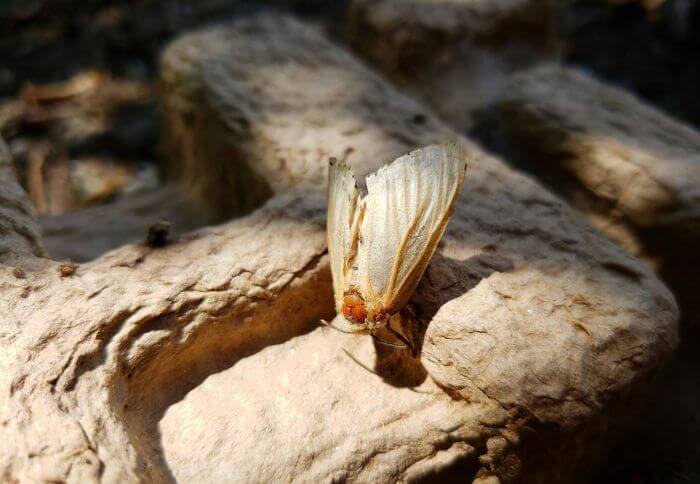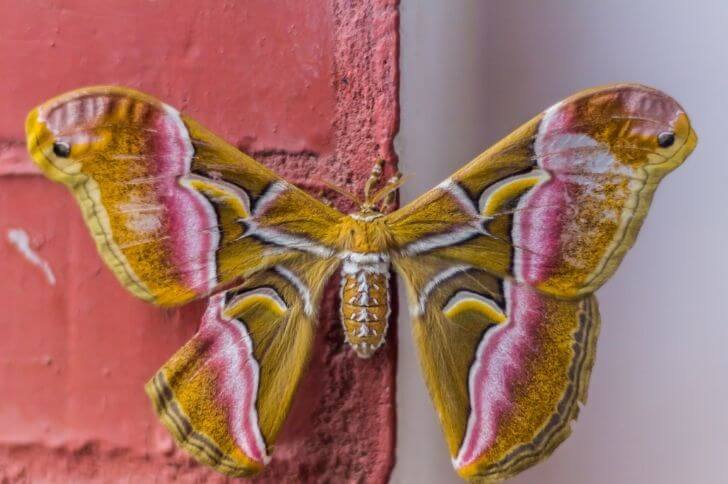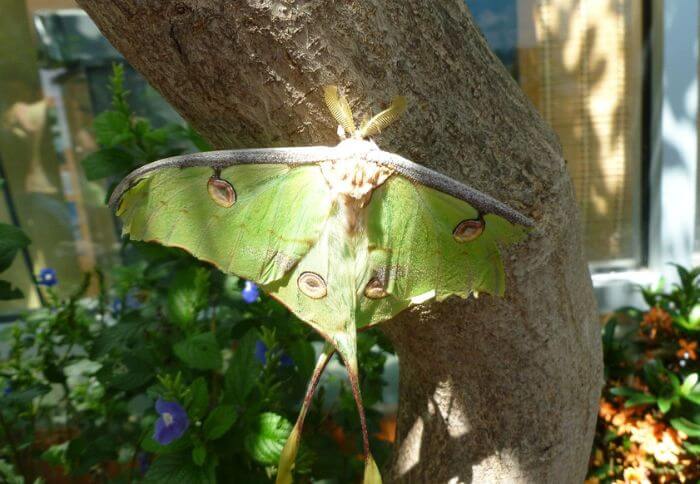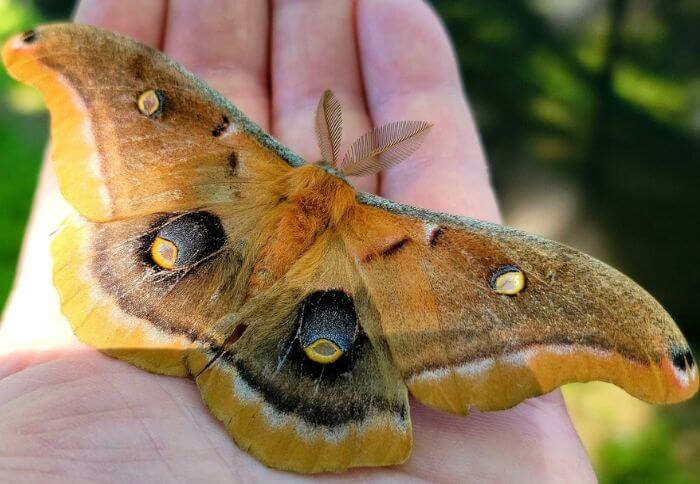10 Orange and Brown Moths (with Pics)
Moths, with their delicate wings and mysterious nighttime habits, have long captured the imagination of nature enthusiasts and casual observers alike.
Among the most captivating species are the orange and brown moths, which adorn gardens, forests, and fields around the world with their subtle beauty.
While these moths may seem unassuming at first glance, a closer look reveals a stunning variety of patterns, colors, and behaviors that make them truly fascinating to study.
From the vibrant hues of the Polyphemus Moth to the intricate patterns of the orange underwing moth, orange and brown moths come in a diverse array of shapes and sizes.
Some are masters of camouflage, blending seamlessly into tree bark or fallen leaves, while others flaunt bold markings meant to deter predators.
As we delve into this exploration of these enchanting creatures’ world, we will uncover not only their physical characteristics but also their essential roles in ecosystems as pollinators and indicators of environmental health.
Join us on an enthralling journey through the enchanting realm of orange and brown moths as we unravel their secrets and discover just how extraordinary these seemingly ordinary insects truly are.
List of Orange and Brown Moths
1. Polyphemus Moth

The Polyphemus moth, with its striking orange and brown wings, is a mesmerizing creature that captivates the imagination. Its vibrant colors and intricate patterns make it a distinct and beautiful member of the moth family.
What sets the Polyphemus moth apart is its impressive size, with a wingspan reaching up to 6 inches, making it one of the largest moths in North America. This colossal size grants it an imposing presence as it flutters through the night sky.
Despite its large size, the Polyphemus moth is surprisingly elusive during daylight hours, blending seamlessly into tree bark thanks to its earthy tones. But when night falls, these magnificent creatures emerge from their hiding places to embark on their nocturnal pursuits.
Their graceful flight and enchanting appearance make them a sought-after sight for insect enthusiasts and nature lovers alike.
Observing a Polyphemus moth in its natural habitat is an awe-inspiring experience that leaves an indelible impression on those fortunate enough to witness it firsthand.
2. Royal Walnut
The royal walnut, with its rich hues of orange and brown, is a symbol of elegance and sophistication in the natural world. Known for its regal appearance, this majestic tree produces walnuts that are not only delicious but also highly prized for their health benefits.
From its striking foliage to its robust wood, the royal walnut exudes a sense of grandeur that commands attention.
In addition to its visual appeal, the royal walnut plays an important ecological role in supporting diverse wildlife species. Its nuts serve as a vital food source for various animals, while the tree itself provides shelter and nesting sites for birds and insects.
Furthermore, the royal walnut’s deep roots help stabilize soil and prevent erosion, contributing to overall ecosystem health.
With its captivating charm and ecological significance, the royal walnut stands as a fitting testament to nature’s inherent beauty and resilience.
Whether admired in a woodland setting or savored in culinary delights, this magnificent tree continues to inspire awe and admiration among nature enthusiasts worldwide.
3. Hyalophora Cecropia (Cecropia Moth)
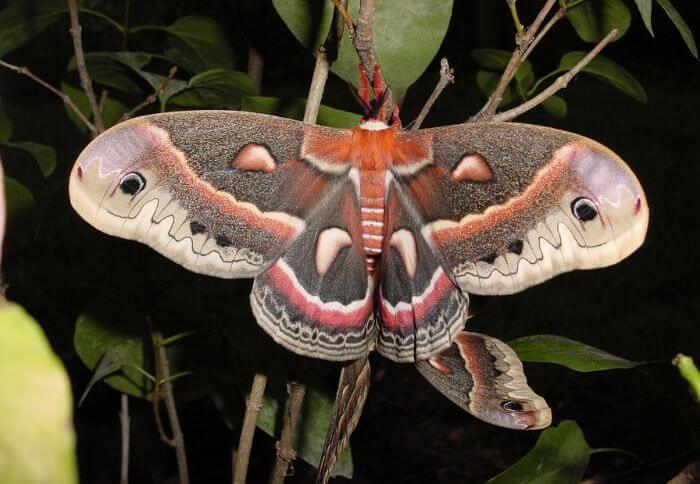
Hyalophora cecropia, also known as the Cecropia moth, is a stunning creature that captivates with its vibrant orange and brown markings. The intricate patterns on its wings resemble beautiful watercolor paintings, making it a true marvel of nature.
This magnificent moth is the largest in North America, with a wingspan that can reach up to six inches, adding to its allure and grandeur.
Despite its size and striking appearance, the Cecropia moth has a short lifespan as an adult, living only about two weeks.
During this brief period, it focuses on reproduction, laying eggs that will give rise to the next generation of these mesmerizing creatures.
Its delicate yet powerful presence in the natural The lifecycle of the Cecropia moth is a remarkable journey filled with transformation and world reminds us of the ephemeral beauty found in unexpected places.
adaptation. From humble caterpillar beginnings to an awe-inspiring winged wonder, this species reflects nature’s capability for metamorphosis and renewal.
As we observe these graceful creatures flit through our gardens and woodlands, we are reminded of the enduring cycle of life that continues to inspire and enchant us.
4. Regal Moth
The regal moth, also known as the royal walnut moth, is a stunning creature that commands attention with its vibrant orange and brown coloration.
This majestic insect boasts a wingspan of up to six inches, making it one of the largest moths in North America. Its intricate patterns and striking colors make it a sight to behold in the wild, captivating nature enthusiasts and casual observers alike.
What makes the regal moth particularly fascinating is its short but remarkable lifespan. As an adult, it only lives for about one week, during which time it must mate and lay eggs before succumbing to its brief existence.
This fleeting moment of beauty adds an air of mystique and urgency to the regal moth’s life cycle, emphasizing the transient nature of natural phenomena.
Furthermore, its prominent size and eye-catching appearance serve as a reminder of nature’s ability to produce creatures that are both beautiful and ephemeral.
Related Read: Check white furry moths
5. Orange Underwing Moth
The orange underwing moth, also known as the Archiearis parthenias, is a stunning creature of the night with its vibrant orange and brown wings.
Often spotted fluttering through woodland areas, this moth captures the imagination with its delicate appearance and graceful flight.
What makes this moth particularly intriguing is its unique reproductive strategy – the female will lay her eggs on trees such as birch or alder during the autumn where they will remain until spring before hatching.
This specialized trait reflects the remarkable adaptability of these enchanting creatures to their environment.
Despite its small size, the orange underwing moth plays a vital role in its ecosystem as an important pollinator for various plant species.
Its nocturnal behavior also contributes to maintaining a natural balance within food chains, making it an integral part of our biodiversity.
The mysterious allure of this brown and orange moth, coupled with its ecological significance, serves as a reminder of the intricate wonders that exist within our natural world.
Indeed, taking a moment to appreciate these seemingly mundane yet fascinating creatures can provide us with a renewed sense of awe and appreciation for the diverse beauty that surrounds us.
6. Herald Moth
The herald moth, with its striking orange and brown wings, is a mesmerizing creature that epitomizes the beauty of nature. Its intricate patterns and delicate structure make it a wonder to behold up close.
Interestingly, the distinct coloration serves not only as a visual feast for the eyes but also as a form of protection. The vibrant hues act as a deterrent to predators, warning them of potential toxicity or bad taste.
As night falls, the herald moth emerges from its daytime hiding spot to take flight under the cover of darkness. This nocturnal behavior adds an air of mystery to its already captivating presence.
Not only does this creature contribute to the ecosystem through pollination and serving as a food source for other animals, but it also enchants us with its graceful movements and silent presence in the twilight hours. Truly, the herald moth is an enchanting symbol of natural beauty and resilience in our world.
7. Southern Ugly-Nest Caterpillar Moth
The Southern Ugly-Nest Caterpillar Moth may not have the most appealing name, but its unique appearance and fascinating life cycle make it a compelling subject of study.
This moth species is known for its vibrant orange and brown coloration, which gives it an eye-catching and distinctive look. Despite its unflattering common name, the intricate patterns on its wings and body reveal a surprising beauty that cannot be overlooked.
What sets this moth apart is its intriguing life cycle. The larvae of the Southern Ugly-Nest Caterpillar Moth are particularly striking, with their long tufts of hair-like spines and bright colors that serve as a warning to predators.
Their transformation from caterpillar to moth is a mesmerizing process, shedding light on the incredible adaptability and resilience of these creatures.
As adults, they play an important role in their ecosystem as pollinators, contributing to the natural balance of their environment through their interactions with various plants and flowers.
8. Large Yellow Underwing
The large yellow underwing (Noctua pronuba) is a striking sight in the late summer and early autumn, with its vibrant yellow hindwings that flash when it takes flight.
This nocturnal moth boasts a wingspan of up to 70mm, making it an impressive presence as it flits around gardens and woodlands.
Despite its mesmerizing appearance, the large yellow underwing often goes unnoticed during the day, resting camouflaged amongst foliage with its intricately patterned forewings blending seamlessly into the surroundings.
What truly sets the large yellow underwing apart is its remarkable ability to adapt and thrive in diverse environments.
From urban parks to rural habitats, this resilient moth demonstrates incredible resilience in the face of changing landscapes. Its larval stage feeds on a wide range of plants, including nettles and grasses, showcasing the moth’s adaptability and broad dietary preferences.
It serves as a testament to nature’s ingenuity and serves as a reminder of the awe-inspiring diversity present in our natural world.
9. Xestia Castanea (Neglected Moth)
What sets the Xestia castanea apart from other moths is its remarkable ad
The Xestia castanea, commonly known as the neglected moth, is a fascinating insect with its intricate patterns of orange and brown wings.
This species is widely distributed across Europe and North America, often found in woodlands and moorlands where its caterpillars feed on various herbaceous plants.
One intriguing aspect of the chestnut moth is its ability to camouflage itself against tree barks, making it a visually stunning illustration of natural selection at work.aptability to changing environments.
As temperatures rise due to climate change, these moths have been observed altering their breeding and feeding patterns to survive in new conditions.
This flexibility showcases nature’s resilience and highlights the interconnectedness between species and their ecosystems.
Despite being seemingly inconspicuous at first glance, the chestnut moth serves as a powerful example of how even the smallest creatures play a significant role in maintaining ecological balance.
10. Milkweed Tussock Moth
The Milkweed Tussock Moth, with its striking orange and brown coloration, is a delightful addition to any natural landscape.
Its vibrant hues serve as a warning to predators that it contains toxic chemicals obtained from feeding on milkweed plants in its larval stage.
This fascinating adaptation enables the moth to defend itself and survive in a world full of potential threats. But beyond its physical appearance, the lifecycle of the Milkweed Tussock Moth offers valuable lessons about resilience and adaptation in the face of adversity.
One cannot help but marvel at the intricate relationship between the Milkweed Tussock Moth and milkweed plants. The moth’s ability to digest toxic compounds from milkweed reflects nature’s incredible ingenuity in developing defense mechanisms.
This unique coevolutionary bond serves as a testament to the interconnectedness of all living organisms, highlighting how each species has evolved specific traits to thrive within their ecological niche.
The colorful presence of these moths adds dimension and beauty to our natural surroundings while serving as a powerful reminder of nature’s endless capacity for wonder and discovery.
Final Thoughts:
The diversity of orange and brown moths is truly fascinating, with a wide range of species exhibiting unique characteristics and behaviors. From the beautiful color variations to their remarkable adaptations for survival, these moths play crucial roles in various ecosystems.
Understanding the different types of orange and brown moths not only enriches our knowledge of nature but also enhances our appreciation for the intricate web of life on Earth.
As we continue to study and protect these delicate creatures, let us strive to maintain their habitats and ensure their continued existence for generations to come. The more we learn about these enchanting moths, the more we can work towards preserving their natural beauty and significance in our world.
sources:
Passionate animal photographer with an unwavering love for capturing the essence and beauty of our furry friends.
With over five years of experience in the field, I have developed a unique ability to connect with animals on a deeper level, allowing me to create stunning and captivating images that truly reflect their personality.
Let’s collaborate to capture unforgettable moments that celebrate the unique bond between humans and animals!
